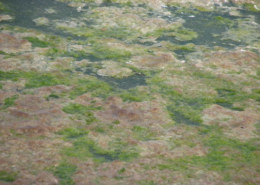Why Spirogyra Has Spiral Chloroplasts ?
Spirogyra is a genus of green algae that belong to the order Zygnematales.These free-flowing, filamentous algae have ribbon-shaped chloroplasts that are arranged in a helical manner inside the cells.
So the name is derived from the spiral arrangement of chloroplasts in these algae. This feature is unique to this genus, which has around 400 species.

Spirogyras are filamentous green algae, named for their obviously spiral chloroplasts.
This Is Why Spirogyra Has Spiral Chloroplasts
Spirogyra has long, unbranched filaments with cylindrical cells that are connected end to end. The cell wall is made up of an outer layer of pectin and an inner layer of cellulose. The inner surface of the cell wall is lined with a thin layer of cytoplasm.
The spiraled ribbon-shaped chloroplasts are embedded in this cytoplasm layer. The number of chloroplast strands in each cell may vary between 1 to 16.
Each chloroplast strand has several round bodies called ‘pyrenoids’, which are responsible for starch production. Each cell has a central vacuole, and a prominent nucleus that is suspended by thin strands of cytoplasm that are attached to the inner part of the cell wall.
The cells are long and thin, and each spirogyra filament measures between 10 to 100 micrometer in width. Sometimes, these filaments develop root-like structures for attaching themselves to the substrate.

Each cell of the filaments features a large central vacuole, within which the nucleus is suspended by fine strands of cytoplasm.
The chloroplasts form a spiral around the vacuole and have specialized bodies known as pyrenoids that store starch. The cell wall consists of an inner layer of cellulose and an outer layer of pectin, which is responsible for the slippery texture of the algae.
Spirogyra species can reproduce both sexually and asexually. Asexual, or vegetative, reproduction occurs by simple fragmentation of the filaments.
Sexual reproduction occurs by a process known as conjugation, in which cells of two filaments lying side by side are joined by outgrowths called conjugation tubes.
This allows the contents of one cell to completely pass into and fuse with the contents of the other. The resulting fused cell (zygote) becomes surrounded by a thick wall and overwinters, while the vegetative filaments die.
Credit:
https://www.britannica.com/science/Spirogyra



Leave an answer
You must login or register to add a new answer.